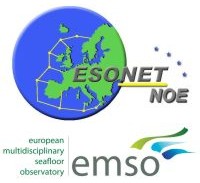Deep-Ocean Observatories
Society now depends on timely information on climate, weather, water, ecosystems, biodiversity, energy resources, and natural disasters. A range of important ocean and Earth processes have been identified using traditional research tools, but achieving an effective understanding of how these processes interact to understand, for example, impacts from climate change has not been possible through expedition-based oceanography alone. The deeper and more remote the ocean - the more challenging it has been to get needed measurement. It’s now widely recognised that in order to bridge gaps in understanding a network of observation sites is needed that collects data across a range of scales and disciplines. After all, some of the most remarkable environmental conditions occur when ships cannot be present because of intense weather.
 Within Europe the European Seas Observatory NETwork (ESONET) Network of Excellence and the European Multidisciplinary Seafloor Observatory (EMSO) Preparatory Phase (PP) programmes have several key aims related to creating a more comprehensive ocean observatory network in Europe including:
Within Europe the European Seas Observatory NETwork (ESONET) Network of Excellence and the European Multidisciplinary Seafloor Observatory (EMSO) Preparatory Phase (PP) programmes have several key aims related to creating a more comprehensive ocean observatory network in Europe including:-
Create lasting integration of European research using deep-sea observatories capable of meeting societal needs for measuring across broad temporal & spatial scales
-
Demonstrate integration of researchers, institutes, & industrial partners
-
Define detailed objectives & design requirements and systematically address challenges of creating the needed system
-
Produce a practical plan for long-term monitoring of the deep-ocean environment as part of Global Earth Observation System of Systems (GEOSS) & Global Monitoring for Environment and Security (GMES)
